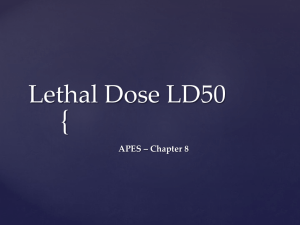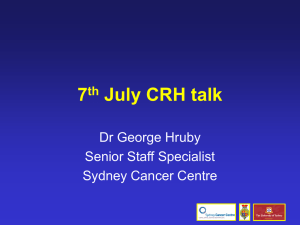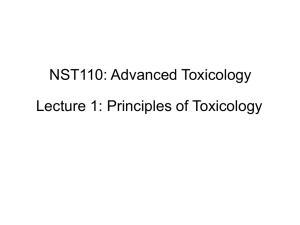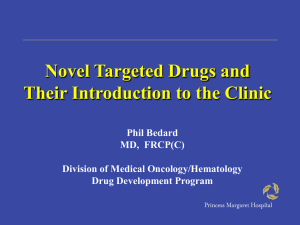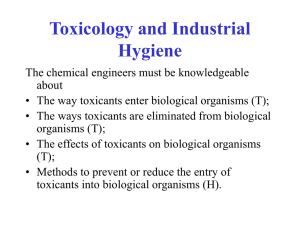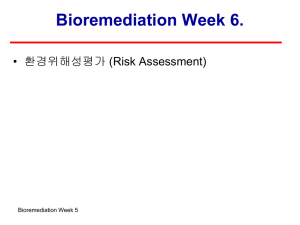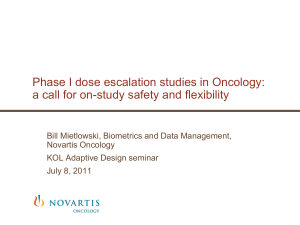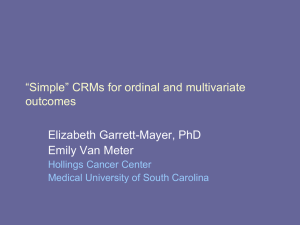Phase I Clinical Trials
advertisement
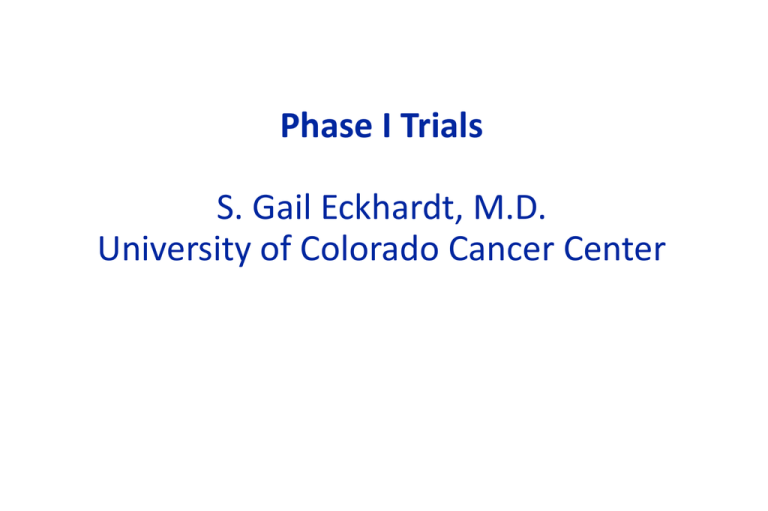
Phase I Trials S. Gail Eckhardt, M.D. University of Colorado Cancer Center Phase I Clinical Trials: Definitions • Toxicity: side effects. These are generally graded using a standard (NCI) scale from 1 (mild)-4 (severe). • Maximum Tolerated Dose (MTD): this is the dose where no more than 30% of patients treated will experience dose-limiting toxicity (DLT). • Phase II trials are often conducted at or near the MTD. • Dose Limiting Toxicity: toxicity that is considered severe enough to limit further dose escalation, such as severe (grade 4) hematologic toxicity or moderate (grade 3) non-hematologic toxicity. Phase I Clinical Trials: Definitions • Pharmacokinetics (PK): the testing of blood and urine in Phase I trials to determine where and how the drug is distributed in the body and eliminated. • Pharmacodynamics (PD): the physiological/biological impact of a drug on the patient such as lowering of blood counts or effect on tumor tissue or biomarker. • Recommended Phase II dose: the dose that has been determined to be tolerable in > 70% of cancer patients and is used for testing in Phase II efficacy trials. • Expanded Cohort: Enrollment of patients at the end of a Phase I trial of a particular tumor type and/or genetic subtype. What Is Needed To Do A Phase I Study? Investigational New Drug Application (IND) to the FDA: • A formal application to study an intervention in patients that can be sponsored (submitted) by: • Commercial-sponsor usually a pharmaceutical company • Investigator • Provides a regulatory framework for advancing from preclinical to clinical testing • Required for products that are not approved/marketed • Required for marketed products being tested in a new disease (indication) General Contents of an IND Application • Chemistry, manufacturing, and control information • Animal pharmacology (includes efficacy) and toxicology • Genotoxicity • Histopathology • Non-clinical justification for proposed dose/schedule (using toxicology data) • Prior use in humans if applicable • Clinical protocol and investigator information • Note: Data supporting dose/schedule and drug product is performed under Good Laboratory Practice (GLP) conditions IND Application- cont’d Once submitted, there is a 30-day review clock that starts • If you hear nothing: You are good to go as long as you have IRB approval! • A day or so before, you may be contacted requesting further information, then be granted approval, or • You could be put on Clinical Hold, due to • Safety concerns, inadequate drug information, etc. • Clinical trial design that will not allow protocol objectives to be met This generally leads to teleconference between sponsor and FDA medical reviewer about what is required to lift the hold What are the Primary Endpoints of a Phase I Trial? • To characterize and quantify the toxicities of a new agent. • To determine the dose-limiting toxicities (DLTs) and maximum tolerated dose (MTD). • To characterize the pharmacology of the agent. • To assess overall tolerability and feasibility. Note that in oncology, cancer patients traditionally participate in Phase I testing, not normal volunteers (although some drugs are tested in both). What are Some Examples of Secondary Endpoints in Phase I Trials? • To assess the extent of preliminary anti-tumor activity. • To determine if there are pharmacokinetic/ pharmacodynamic relationships (PK/PD). • For targeted agents, to assess the feasibility and utility of a biological correlative assay. Increasingly phase I trials have numerous secondary endpoints that sometimes are used as go/no-go decision points for moving forward with a drug What are the Key Elements Required in a Phase I Protocol to Accomplish these Objectives? • Justification of the starting dose and dose escalation plan. • Appropriate patient eligibility/ exclusion criteria. • Definition of DLT, MTD, and recommended phase II dose. • Pharmacokinetic sampling schedule. • A study calendar for safety assessments. • Tumor assessment criteria and schedule. • Reporting requirements for adverse events and serious adverse events. • Consent form and other regulatory items. Justification of the Starting Dose in Humans • The starting dose of a drug that has not been in a human is based upon animal toxicology studies- usually in mice, rats, dogs, non-human primates. • In general, 1/10th of the dose that leads to deaths in 10% (LD10) of the animals is used in man. • This dose is usually in mg/kg, so it must be converted to mg/m2 for man- and there are conversion tables for this. • If toxicology is performed in several species, then the LD10 is used from the most sensitive species. • 1/3rd of the lowest toxic dose is used in larger animals This is very rudimentary and traditional, a lot of work is going into refining these rules, particularly with targeted agents Example of Determination of Starting Dose: DFM (difungal muctane): standard cytotoxic agent that you will be using on an every 3 week (Q3W) schedule, toxicology results: • • • • LD10 in rats was 50 mg/kg as a single dose. LD10 in mice was 10 mg/kg on a Q3W schedule. TDL was 50 mg/kg in dogs on a weekly schedule. TDL was 24 mg/kg in dogs on a Q3W schedule. The only relevant results to use are those from the same schedule, although the other schedules give you information on schedule-dependent toxicity: 1/10 LD10= 1 mg/kg x conversion factor of 3= 3 mg/m2 1/3 TDL= 8 mg/kg x conversion factor of 20= 160 mg/m2 Dose Escalation Scheme and Schedule Factors to be considered •Are there significant inter-species differences in tolerance? (as in prior example: how fast, how slow for dose escalation) •Is the drug a typical cytotoxic agent or more targeted agent? •What is the PK half-life? (short vs. long) •Does the therapeutic index appear narrow? (slower dose escalation) •Is cumulative toxicity an issue? (may need to assess longer than 30 days for dose limiting toxicity) •Is there schedule-dependent toxicity or efficacy? (continuous vs. intermittent) •What is the formulation? (can’t give daily IV) Frequently Used Dose Escalation Schemes • Modified Fibonacci: sequentially smaller increments of dose escalation- 100%, 67%, 50%, 40%, 33%, etc. • Doubling method: doubling of the dose until any grade 2 drug-related toxicity, then reversion to modified Fibonacci or fixed (25-40%) dose escalation. • Pharmacologically guided: use of real-time PK data to guide escalation with intent to achieve target AUC. • Continual Reassessment Method (CRM): statistically-guided dose escalation that uses real-time toxicity data to predict the dose closest to the MTD. • Accelerated Titration Design: a constellation of designs that utilize single-patient toxicity-guided escalations (intra-patient dose escalation allowed). Phase I “Standard” 3 + 3 Design Bottom line is that there are many ways to do this and a lot of flexibility as long as it is safe for patients! Patient Eligibility Criteria: Inclusion The purpose of inclusion criteria are to define the minimum requirements of the phase I population under study: • Regulatory: Signed consent, age > 18. • Disease: Failed standard therapy (or no standard therapy exists), histologically confirmed. • Constitutional: Performance status 0-2 (out of bed > 50%) • Organ function: ANC > 1500/uL; plts > 100 K/uL; hgb > 9 g/dL; creatinine < 1.5 g/dL, SGPT/SGOT 2-5 X ULN, total bilirubin < ULN. • Mental: Able to comprehend and comply with study requirements. Patient Eligibility Criteria: Exclusion The purpose of exclusion criteria are to minimize the risks of drug-related toxicity, thus some are agent-specific: • Constitutional: Almost all phase I studies exclude pregnancy due to the lack of information on fetal effects, as well as other serious underlying medical diseases. • Prior therapy: For myelosuppressive compounds, patients with extensive prior therapy are excluded. • Cardiac: Patients may be excluded with known underlying diseases, or may require a MUGA, EKG, etc. • Gastrointestinal: Studies of oral drugs exclude patients with refractory N/V or extensive bowel surgery. Typical Definitions of DLT Dose escalation proceeds, as planned, with 1-3 patients until DLT occurs, as typically defined by: • Grade 4 neutropenia for > 5 days, or complicated by fever requiring antibiotics. • Platelets < 25, 000/uL. • Non-hematologic toxicity > grade 3 (tailored for agent). • Chronic > grade 2 toxicity. Once DLT occurs, up to 6 patients are treated to assess the frequency. Definition of the MTD • The MTD is generally defined as the dose in which less than 2 of 6 new patients develop DLT in the first cycle. • In some places, the MTD is the dose level where > 2/6 patients develop DLT. • In any event, DLT is generally allowed in up to 30% of the population. • The MTD is not always the recommended dose for phase II testing. • In general, at least 10-12 patients should be treated at the MTD. Why the MTD ≠ Dose to be used in Phase II • DLT and MTD are used for the purposes of making decisions about dose escalation. • The occurrence of DLT in the first course of therapy is what limits dose escalation. • The phase II dose should incorporate multiple-cycle toxicity (including DLT), tolerability, dose reductions, and dose delays. • This distinction should be clarified in the protocol. Biological Correlative Studies: Why are They Important? In early clinical trials of targeted agents: • Normal tissue may not be used as a surrogate for effects, as is the case with standard cytotoxic agents • The relative lack of toxicity to normal tissue often means that deriving the MTD, or optimal biological dose may be difficult. • Therefore, biological correlative studies may be used to derive the best dose and schedule of an agent, and • To determine whether the drug is inducing a biological effect in the patient before advancing to phase II. Biomarker Definitions: Pharmacodynamic (PD) biomarker: Associated with drug exposure- commonly used in Phase I trials. Example: Reduction in p-ERK in PBMCs post-MEK inhibitor Predictive biomarker: Predicts outcome to therapy- most common in Phase II trials. Example: KRAS/BRAF mutation, Her2/Neu, ER/PR Prognostic biomarker: Associated with outcome, independent of therapy- often discovered retrospectively in Phase III trials. Example: Ki67 index PD Biomarker: Decrease in Ki67 (top) and pERK1/2 (bottom) in skin biopsies following PF299804 (pan-EGFR TKI) treatment. Jänne P A et al. Clin Cancer Res 2011;17:1131-1139 ©2011 by American Association for Cancer Research How to Become Famous How To Become Famous in Phase I: Expanded Cohorts using Predictive Biomarkers!!! Vemurafenib/BRAF MU melanoma Crizotinib/ALK+ NSCLC Thank You!
